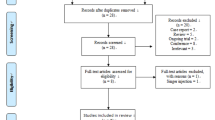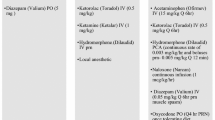Abstract
Background
PCA- and block-based enhanced recovery after surgery (ERAS) pathways have been shown to decrease hospital length of stay (HLOS) and opiate use following Nuss Repair for Pectus Excavatum (NRPE). No thoracic epidural-based ERAS pathway has demonstrated similar benefits.
Methods
In this pre-post single-center study, data were retrospectively collected for patients ≤ 21 years undergoing NRPE from May 2015 to August 2019. Univariate and multivariate methods were used to evaluate whether implementation of a thoracic epidural-based ERAS in April 2017 was associated with HLOS, opiate use, or pain scores.
Results
There were 110 patients: 35 pre- and 75 post-ERAS. HLOS decreased from median 4.8 (1.1) to 3.3 (0.6) days with ERAS (p < 0.001). Use of rescue intravenous opiates decreased from 35.3% pre- to 9.3% with ERAS (p = 0.013). When adjusted for baseline characteristics, ERAS was associated with a 1.3 ± 0.2 day decrease in HLOS and 0.188 times the odds of rescue intravenous opiate use (p = 0.011).
Conclusions
Pain scores, ED visits, and readmissions did not change with ERAS (p > 0.05). Implementation of a thoracic epidural-based ERAS following NRPE was associated with decreased HLOS and need for any rescue intravenous opiates without a change in pain scores, ED visits, or readmission.



Similar content being viewed by others
Abbreviations
- NRPE:
-
Nuss repair for pectus excavatum
- PCA:
-
Patient-controlled analgesia with intravenous opiates
- HLOS:
-
Hospital length of stay
- ERAS:
-
Enhanced recover after surgery
References
Obermeyer RJ, Goretsky MJ (2012) Chest wall deformities in pediatric surgery. Surg Clin North Am 92(3):669–684 (ix)
Malek MH, Fonkalsrud EW, Cooper CB (2003) Ventilatory and cardiovascular responses to exercise in patients with pectus excavatum. Chest 124(3):870–882
Gibreel W, Zendejas B, Joyce D, Moir CR, Zarroug AE (2016) Minimally invasive repairs of pectus excavatum: surgical outcomes, quality of life, and predictors of reoperation. J Am Coll Surg 222(3):245–252
Malek MH, Berger DE, Housh TJ, Marelich WD, Coburn JW, Beck TW (2006) Cardiovascular function following surgical repair of pectus excavatum: a metaanalysis. Chest 130(2):506–516
Kubiak R, Habelt S, Hammer J, Hacker FM, Mayr J, Bielek J (2007) Pulmonary function following completion of minimally invasive repair for pectus excavatum (MIRPE). Eur J Pediatr Surg 17(4):255–260
Fonkalsrud EW, Dunn JC, Atkinson JB (2000) Repair of pectus excavatum deformities: 30 years of experience with 375 patients. Ann Surg 231(3):443–448
Beiser GD, Epstein SE, Stampfer M, Goldstein RE, Noland SP, Levitsky S (1972) Impairment of cardiac function in patients with pectus excavatum, with improvement after operative correction. N Engl J Med 287(6):267–272
Ravitch MM (1949) The operative treatment of pectus excavatum. Ann Surg 129(4):429–444
Nuss D, Kelly RE Jr, Croitoru DP, Katz ME (1998) A 10 year review of a minimally invasive technique for the correction of pectus excavatum. J Pediatr Surg 33(4):545–552
Papic JC, Finnell SM, Howenstein AM, Breckler F, Leys CM (2014) Postoperative opioid analgesic use after Nuss versus Ravitch pectus excavatum repair. J Pediatr Surg 49(6):919–923 (discussion 23)
Singhal NR, Jones J, Semenova J, Williamson A, McCollum K, Tong D et al (2016) Multimodal anesthesia with the addition of methadone is superior to epidural analgesia: a retrospective comparison of intraoperative anesthetic techniques and pain management for 124 pediatric patients undergoing the Nuss procedure. J Pediatr Surg 51(4):612–616
Lukosiene L, Macas A, Trepenaitis D, Kalibatiene L, Malcius D, Barauskas V (2014) Single shot intercostal block for pain management in pediatric patients undergoing the Nuss procedure: a double-blind, randomized, controlled study. J Pediatr Surg 49(12):1753–1757
Loftus PD, Elder CT, Russell KW, Spanos SP, Barnhart DC, Scaife ER et al (2016) Paravertebral regional blocks decrease length of stay following surgery for pectus excavatum in children. J Pediatr Surg 51(1):149–153
Hall Burton DM, Boretsky KR (2014) A comparison of paravertebral nerve block catheters and thoracic epidural catheters for postoperative analgesia following the Nuss procedure for pectus excavatum repair. Paediatr Anaesth 24(5):516–520
Choudhry DK, Brenn BR, Sacks K, Reichard K (2016) Continuous chest wall ropivacaine infusion for analgesia in children undergoing Nuss procedure: a comparison with thoracic epidural. Paediatr Anaesth 26(6):582–589
Butkovic D, Kralik S, Matolic M, Kralik M, Toljan S, Radesic L (2007) Postoperative analgesia with intravenous fentanyl PCA vs epidural block after thoracoscopic pectus excavatum repair in children. Br J Anaesth 98(5):677–681
Dekonenko C, Dorman RM, Duran Y, Juang D, Aguayo P, Fraser JD et al (2020) Postoperative pain control modalities for pectus excavatum repair: a prospective observational study of cryoablation compared to results of a randomized trial of epidural vs patient-controlled analgesia. J Pediatr Surg 55(8):1444–1447
Stroud AM, Tulanont DD, Coates TE, Goodney PP, Croitoru DP (2014) Epidural analgesia versus intravenous patient-controlled analgesia following minimally invasive pectus excavatum repair: a systematic review and meta-analysis. J Pediatr Surg 49(5):798–806
Graves CE, Moyer J, Zobel MJ, Mora R, Smith D, O’Day M et al (2019) Intraoperative intercostal nerve cryoablation During the Nuss procedure reduces length of stay and opioid requirement: a randomized clinical trial. J Pediatr Surg 54(11):2250–2256
Muhly WT, Maxwell LG, Cravero JP (2014) Pain management following the Nuss procedure: a survey of practice and review. Acta Anaesthesiol Scand 58(9):1134–1139
Ljungqvist O, Scott M, Fearon KC (2017) Enhanced recovery after surgery: a review. JAMA Surg 152(3):292–298
Medbery RL, Fernandez FG, Khullar OV (2019) ERAS and patient reported outcomes in thoracic surgery: a review of current data. J Thorac Dis 11(Suppl 7):S976–S986
Holmes DM, Polites SF, Roskos PL, Moir CR (2019) Opioid use and length of stay following minimally invasive pectus excavatum repair in 436 patients—benefits of an enhanced recovery pathway. J Pediatr Surg 54(10):1976–1983
Wharton K, Chun Y, Hunsberger J, Jelin E, Garcia A, Stewart D (2020) Successful use of an enhanced recovery after surgery (ERAS) pathway to improve outcomes following the Nuss procedure for pectus excavatum. J Pediatr Surg 55(6):1065–1071
Mangat S, Hance L, Ricketts KJ, Phillips MR, McLean SE (2020) The impact of an enhanced recovery perioperative pathway for pediatric pectus deformity repair. Pediatr Surg Int 36(9):1035–1045
Tsze DS, von Baeyer CL, Pahalyants V, Dayan PS (2018) Validity and reliability of the verbal numerical rating scale for children aged 4 to 17 years with acute pain. Ann Emerg Med 71(6):691-702 e3
Opioid Morphine EQ Conversion Factors, https://www.cms.gov/Medicare/Prescription-Drug-Coverage/PrescriptionDrugCovContra/Downloads/Opioid-Morphine-EQ-Conversion-Factors-Aug-2017.pdf; 2017 [Accessed April 1, 2020.2020].
Brown JK, Singh K, Dumitru R, Chan E, Kim MP (2018) The benefits of enhanced recovery after surgery programs and their application in cardiothoracic surgery. Methodist Debakey Cardiovasc J 14(2):77–88
Litz CN, Farach SM, Fernandez AM, Elliott R, Dolan J, Nelson W et al (2017) Enhancing recovery after minimally invasive repair of pectus excavatum. Pediatr Surg Int 33(10):1123–1129
Ho KY, Gan TJ, Habib AS (2006) Gabapentin and postoperative pain—a systematic review of randomized controlled trials. Pain 126(1–3):91–101
Kim S, Idowu O, Palmer B, Lee SH (2016) Use of transthoracic cryoanalgesia during the Nuss procedure. J Thorac Cardiovasc Surg 151(3):887–888
Harbaugh CM, Johnson KN, Kein CE, Jarboe MD, Hirschl RB, Geiger JD et al (2018) Comparing outcomes with thoracic epidural and intercostal nerve cryoablation after Nuss procedure. J Surg Res 231:217–223
Funding
This research did not receive any specific grant from funding agencies in the public, commercia, or not-for-profit sectors.
Author information
Authors and Affiliations
Corresponding author
Additional information
Publisher's Note
Springer Nature remains neutral with regard to jurisdictional claims in published maps and institutional affiliations.
Rights and permissions
About this article
Cite this article
Cramm, S.L., Luckhurst, C., Galls, A. et al. Thoracic epidural-based Enhanced Recovery After Surgery (ERAS) pathway for Nuss repair of pectus excavatum shortened length of stay and decreased rescue intravenous opiate use. Pediatr Surg Int 37, 1191–1199 (2021). https://doi.org/10.1007/s00383-021-04934-x
Accepted:
Published:
Issue Date:
DOI: https://doi.org/10.1007/s00383-021-04934-x




